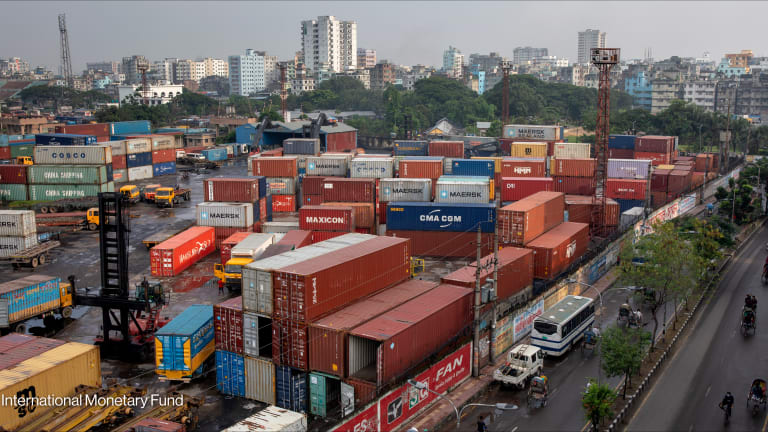Interactive: One decade of Swedish aid
Devex Analytics dives into data for Swedish aid disbursements over the past decade, covering over 53,000 disbursements to 128 countries and 15 regions totaling around $49.6 billion.
Sweden is the largest donor of foreign aid in relation to the size of its economy. It has continuously committed to donating around 1% of gross national income to its official development assistance, making it one of the few countries to actually exceed the United Nations aid target of 0.7%. Despite mounting pressure from far-right parties to reduce ODA, Sweden maintains its longstanding commitment to international development. Currently, the parties in government emphasize democratic governance and human rights, which could lead to an increase in the budget. However, the European economic forecast for Sweden for 2020 predicts a slowdown in economic growth from 1.7% to 1.5%, which could impact the overall ODA budget. Sweden's budget for 2020 proposed an increase in spending in Swedish krona, but an overall decrease in U.S. dollars due to the fluctuation rate. Sweden’s spending through ODA can be both captured through the Organisation for Economic Co-operation and Development and the open government data platform built and maintained by the Swedish International Development Cooperation Agency, in collaboration with the Swedish Ministry of Foreign Affairs. The data contains insights into top recipient countries and organizations, most funded sectors, channeled types of aid, and split between Swedish agencies responsible for disbursing aid. For the purpose of this analysis, we are specifically focusing on Sweden’s ODA spending. Devex Analytics dove into data for Swedish aid disbursements over the past decade. This covers over 53,000 disbursements to 128 countries and 15 regions totaling around $49.6 billion, based on 2019 constant figures. All figures considered in this analysis are for positive disbursements — the total of $461 million of negative values for the 10 years, which indicate repayments, have been excluded. As openaid.se only reports current figures, any figures underpinning this article have been converted to constant ones to allow for historical comparison. Funding trends over time Swedish ODA has overall maintained a relatively stable trend, averaging around $5 billion per year. According to openaid.se, the numbers have been updated as recently as the end of December 2019. However, the total value of aid for that year only totaled approximately $4 billion. According to the government’s budgets, Swedish aid is expected to reach $5.8 billion in 2019 and $6 billion in 2020, based on the same currency conversion rate underpinning the data in this article. In 2018, the most recent year with complete data, there were 4,461 disbursements worth $5.8 billion. The majority of this value, around 65% — or $3.8 billion — consists of core contributions and pooled programs and funds, which includes both tied and untied aid. As Swedish development cooperation budget is both inclusive of bilateral flows to development outside of Sweden and internal costs related to refugees in Sweden, the ODA trend was heavily affected by the refugee crisis in Europe in 2015. A whopping $2.5 billion, or around 37% of the total ODA that year, was allocated to the internal refugee costs. For other years in that decade, the internal refugee costs averaged around 12% of total ODA flows. All of the internal costs for refugees are administered by the Swedish Migration Agency. Beyond the three main agencies, there have been some 22 other agencies involved in the disbursement of Swedish aid in the past decade. Though their flows only accounted for 0.4% of the total value in 2019 and 2.6% in 2018, this group features prominent players such as Swedfund, Sweden’s development finance institution; Folke Bernadotte Academy, the Swedish government agency for peace, security and development; and Swedish Institute, which promotes interest and confidence in Sweden around the world. Development assistance across 143 locations Sweden has disbursed aid to 128 countries and 15 regions over the past 10 years. The top three countries that received the most Swedish aid over the past decade are Afghanistan at $1,093 million, Tanzania at $952 million, and Mozambique at $855 million. In Afghanistan, 98% of disbursements over the past 10 years were implemented by SIDA. The majority of funding to Afghanistan, $676 million, was channeled as part of the Afghanistan 2014-2019 country strategy focusing on five main areas: empowerment, education, employment, enterprise, and economic integration. The priorities directly correspond with the top sectors with the highest amount of funding in the country, as multisector aid was the top sector with $152 million, along with primary education at $136 million and road transport at $81 million. Material and relief assistance and services, at $148 million, underpins the humanitarian assistance 2011-2016 country strategy. Tanzania is not only the second top country with the highest value of disbursements, but also received the highest number of disbursements of any country over the past 10 years, at 1,149. One report published by OECD finds that Swedish aid to Tanzania has been more effective in recent years, though overall has contributed marginally to poverty reduction. Official program evaluations have found Swedish aid in support of the northeastern African country to lack focus, with interventions spread too thin across too many objectives and disbursements. After Tanzania, Kenya is at 1,121, and Uganda at 950. Afghanistan is not even in the top 10, at 580 individual disbursements. In addition to the 128 countries, there are 15 distinct regional disbursements. The biggest one is bilateral unspecified aid, which made up 64%, or $31.7 billion worth, of Swedish aid over the past 10 years. The Ministry of Foreign Affairs implemented the most bilateral unspecified aid, comprising 51% of the aid disbursements, and a large portion, $14.1 billion, of this was channeled as core contributions to multilateral institutions, such as the World Bank, EU bodies, and a number of U.N. agencies. The other top regions receiving the most Swedish aid over the past decade are south of the Sahara at $1 billion, and generic regional support to Africa at $772 million. Sectors and strategic priorities Swedish aid has prioritized eight main focus areas of development assistance in line with the Sustainable Development Goals, with top focuses on human rights, democracy, and the rule of law; climate change; and gender equality. Out of 215 sectors, about 22% of aid has gone to unspecified sectors in the past decade, whereof 92% of aid in unspecified sectors is core contributions to multilateral institutions. The top three specified sectors are refugees in donor countries at around $7.7 billion or 15% of total aid, material relief assistance and services at $3.6 billion or 7%, and multisector aid at $3.1 billion or 6%. Funding toward material relief assistance and services has decreased by 35% since 2016, but our analysis shows this is largely due to the 2011-2016 humanitarian assistance strategy expiring. The sector remains a leading sector for humanitarian assistance and covers support to fragile states, such as the Democratic Republic of the Congo, Syria, Somalia, Sudan, and Yemen. With $288 million, or 7%, of all funding for that year, democratic participation and civil society was the largest sector in 2019, after unspecified sectors. It is also one of the sectors that experienced a steady increase throughout the years, having grown by nearly 50% since 2010. The data also pinpoints the correlation between different sectors and the Swedish agencies responsible for disbursing aid. For instance, nearly all core support is channeled through the Ministry of Foreign Affairs, while SIDA plays a leading role for most of the specific sectoral priorities, such as democratic participation and civil society, human rights, or reproductive health care. There are also sectors, where multiple agencies are involved, such as participation in international peacekeeping operations, split primarily between SIDA, Folke Bernadotte Academy, and Sweden’s National Police Board, as well as formal sector financial intermediaries, primarily funded by Swedfund. Organizations and top disbursements With internal refugee costs making up a large share of Sweden's aid disbursements in the past decade, the Swedish government was the top recipient of aid during that same period, receiving $8.1 billion, or 16% of total aid. More than 80% of these disbursements are concerned with internal costs for refugees in Sweden. In total, over 500 organizations have implemented Swedish aid, including the broad category of international NGOs at $2.9 billion, followed by the category of donor-country based NGOs at $2.6 billion. Developing country-based NGOs as a category is only featured as the 18th largest recipient organization or type of organization, meaning Swedish aid is still primarily disbursed to known Swedish or international NGOs. It is worth noting, however, that several local and international organizations named specifically do not fall under the generic categories. As of 2018, Sweden accounted for 1% of the U.N.’s regular budget and it is also one of the largest donors to U.N. programs and funds. In the past decade, data shows many top organizations include U.N. agencies and other multilateral agencies. For instance, UNICEF has been the leading U.N. agency receiving a big portion of Swedish aid and growing around 120% between 2010 and 2018. Funding to UNICEF finally reached approximately $253 million in 2018, followed by UNDP with $249 million and UNHCR at $158 million, which has peaked in 2015 with $190 million amidst increased spending on refugees. Looking at top individual 20 disbursements in 2018, the vast majority are related to core contributions to multilateral institutions, such as contributions to the development budget of the European Commission, worth nearly $300 million in 2018, or contributions to the International Development Association, at $267 million. Interact with the data on one decade of Swedish aid. For access to funding analysis, the latest funding updates, and opportunities from over 780 sources — in addition to exclusive Devex Pro news content — please get in touch to learn more about a Devex Funding membership.
Sweden is the largest donor of foreign aid in relation to the size of its economy. It has continuously committed to donating around 1% of gross national income to its official development assistance, making it one of the few countries to actually exceed the United Nations aid target of 0.7%.
Despite mounting pressure from far-right parties to reduce ODA, Sweden maintains its longstanding commitment to international development. Currently, the parties in government emphasize democratic governance and human rights, which could lead to an increase in the budget.
However, the European economic forecast for Sweden for 2020 predicts a slowdown in economic growth from 1.7% to 1.5%, which could impact the overall ODA budget. Sweden's budget for 2020 proposed an increase in spending in Swedish krona, but an overall decrease in U.S. dollars due to the fluctuation rate.
This story is forDevex Promembers
Unlock this story now with a 15-day free trial of Devex Pro.
With a Devex Pro subscription you'll get access to deeper analysis and exclusive insights from our reporters and analysts.
Start my free trialRequest a group subscription Printing articles to share with others is a breach of our terms and conditions and copyright policy. Please use the sharing options on the left side of the article. Devex Pro members may share up to 10 articles per month using the Pro share tool ( ).
Maja Wisenberger works in Devex's Analytics team in Manila, assisting in expanding data content and analyzing global funding trends. She has a master's degree in Public Policy from China and she brings experience from UNOPS, UN Women and the nonprofit sector. Her main areas of interest are poverty alleviation, economic and gender equality, and Chinese philanthropy.
Emma Stibi works with the Devex Analytics team based in Copenhagen, where she assists in curation, analysis, and dissemination of development data. She is currently finishing her bachelor’s degree in development studies at Lund University and has also studied in the U.S. and Korea. Her interests include gender equality and disaster risk management.









